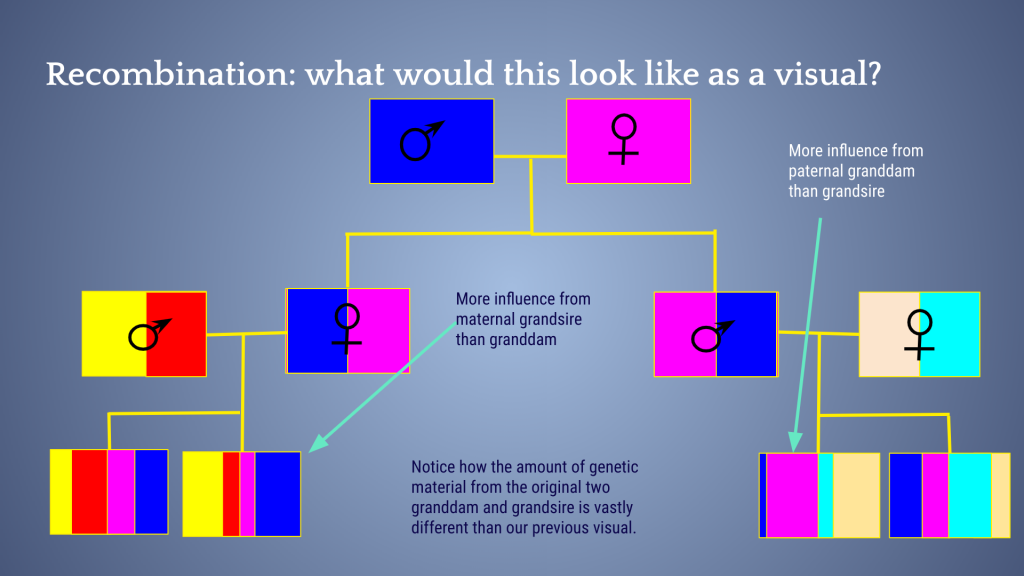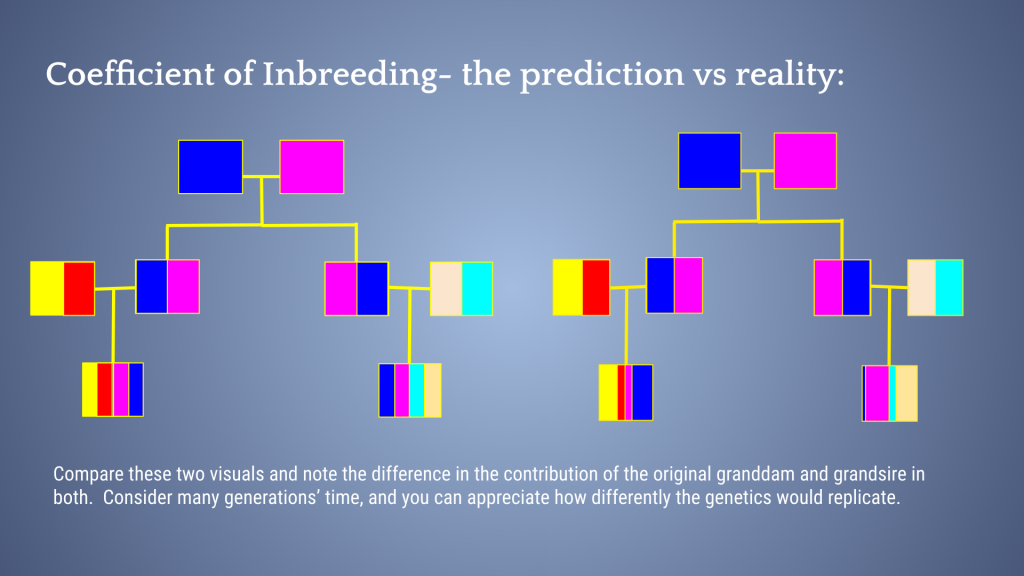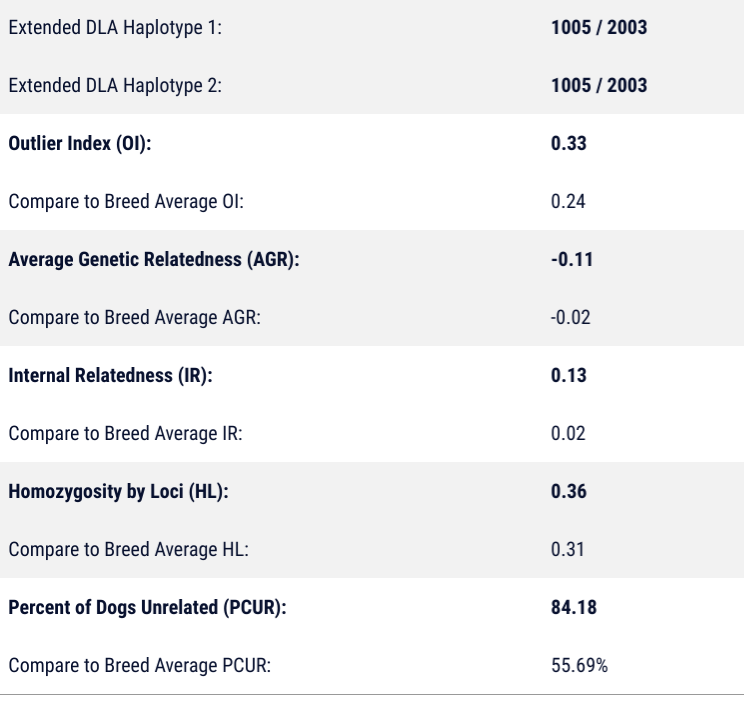
COI is useless?
Yes, COI is useless. There I said it. Or COI is at least limited in scope.
This bears saying again. A low predicted pedigree-based COI in a test breeding does not insure that two dogs are unrelated and will not produce inbred offspring. In fact, depending on the breed, COI is practically useless! The following post explains why we tend to clench our teeth when in groups or in posts people say, “Well my COI is low and I imported a dog for that low COI, so genetic diversity testing isn’t of use to me.” Whether you want to linebreed or have the outcrossiest of the outcrosses, many breeders find it prudent to know how high their inbreeding levels might be – or risk of inheriting a detrimental gene – before choosing to do a breeding.
First of all, what is COI and what does it assume? COI, or coefficient of inbreeding, is a statistical calculation designed to give us a probability that an animal will inherit the exact same gene from the exact same ancestor. Breeders have long relied upon this methodology to estimate how closely related two dogs are, whether they are linebreeding or trying to find an outcross. Why is this no longer our best method?
Let’s investigate further what COI assumes and why COI (and other pedigree based calculations like mean kinship or mk) are no longer our best tools.
COI assumes a few things, which we will will show to be faulty towards the end of this blog. But what are these assumptions? First, that the influence of one ancestor is the same as another ancestor at the same place in the pedigree; this is a faulty assumption (we’ll discuss this later). The image below demonstrates what this COI assumption would look like in a simple pedigree-like image. Each grandparent in this scenario offers exactly 25% of its genetics to each grandchild.

Next, COI also assumes pedigrees are complete (meaning we know the ancestors of dogs back to the inception of breeds) and that the reported dogs in the pedigree were truly the actual parents (we all know parentage is not always correct, be it accidental or otherwise!). This matters because if there is missing or inaccurate information, then the calculation is likewise incorrect. Additionally, COI assumes that the founders of a population were unrelated; this assumption in and of itself could be dangerous.
Another issue: COI is based on an arbitrary particular number of generations selected by the breeder. So, let’s say a breeder selects a 12 generation calculation and the COI comes back .08%. Yipee! Right?! Let’s also say that just behind those 12 generations there was a genetic bottleneck, like a popular sire with subsequent linebreeding on that sire, perhaps decimation of that population due to a World War or decline in popularity of the breed. The genetic bottleneck on the dogs behind the 12th generation will be unapparent with that 12 generation COI calculation. Breeders often think that there will have been evolution or drift away from that popular sire in 12 generations. However, significant genetic mutation does not happen within that time frame, and the dogs 13 generations before are likely very genetically similar to those today. Evolution takes much longer than a century, or half century, of breeding.
Let’s go back to the very first assumption: that the influence of one ancestor is the same as another ancestor at the same place in the pedigree. We know from recombination, something that happens during the formation of gametes, that this is not the case.
Recombination occurs when our bodies, or any animal, create gametes (sperm or eggs). This is a “reshuffling” of the genetic material received from the sire and dam of a dog (and therefore the genes from the grandsires and granddams). This is also called “crossing over”, in which the chromosomes literally switch portions of DNA. This can happen all along the length of each chromosome, in small or large chunks.
So let’s look at another simple pedigree-like picture that demonstrates how this might impact the influence of a particular grandsire or granddam.

Now, let’s take a look back and consider the prediction for COI and compare it to the reality, taking into consideration crossing over. See how different just two generations could be? This also demonstrates why we see so much range in the differences between tested offspring. The influence of one grandparent can be vastly different in one grand puppy than in another.

In addition to considering the effect of recombination, also take in to consideration the impact of the number of generations selected by the breeder for the calculation as well as any unknown parentage issues. The actual variation among descendants can be huge! The above explanation demonstrates why a dog in one country may be very closely related to a dog in another, despite COI predicting otherwise, or vice versa.
How about we look at two actual siblings? How different can they TRULY be?

The following is a discussion of two puppies from the exact same parents – the 12 generation COI for this litter was .59%
The image on the left is the genetic data from our database on the first puppy we will discuss.
This first puppy has an IR of -.28. Now, I know IR is new to many of you, but you should know a very low IR means that a particular dog is VERY outbred (in comparison to the population it belongs to) while a high IR (.15 or so) equates a more inbred dog in that population.
So this puppy is very outbred.
Additionally, the Outlier Index (OI) of this puppy is LOW, meaning it has very typical (or common) genes for its population. This isn’t necessarily bad, but as genetic influence from specific ancestors in a breed becomes more dominant and carried by a majority, the breed is breeding toward a genetic bottleneck.
Similarly, this puppy’s average genetic relatedness (AGR) is relatively high for the breed, meaning it is closely related to many dogs in the population (not surprising given it has genetics typical for the population – ie low OI). This means, when looking for a breeding mate for this puppy, the breeder will have more difficulty finding unrelated mates to with which produce outbred puppies.

So let’s look at a second sibling
This second sibling is drastically different from the first.
First of all, we note that this puppy has an IR that is much higher than the other at .13. This means it is much more inbred, very close to the “high” cut off of .15. Unlike the other, however, this dog has a higher OI (meaning it has genetics less typical for the population) and a lower AGR of -.11, meaning its very unrelated to the population in the database. This means this puppy will be easy to find unrelated mates, should it be bred in the future.
Notice how vastly different these two siblings are from one another, despite both having the same predicted COI of .59%.
Now, of course, neither of these genetic assessments comment on the quality of the dogs in question; this merely gives direction for their management if/when a breeder chooses to have their genetics contribute to the genepool.
In conclusion:
This blog post demonstrates a basis for the argument that genetic testing is FAR more reasonable and reliable for determining the estimation of inbreeding in an individual, as well as the RELATEDNESS among potential pairs. And, we must ask, without a means to determine how related a breeding pair are to one another, what use is knowing how inbred an individual is itself?
One final note on COI – when pedigrees are accurate, and many dogs’ COIs are aggregated, it does give a good perspective on trends in inbreeding for the entire population, though perhaps not individual dogs. Knowing your pedigrees will always be important! Just as knowing the health, temperament, structure, and drive of your lines and sticking to your individual goals as a breeder will always be important.
We have the tools, and have had them for three years now, to genetically estimate the inbreeding of individuals (IR), predict the inbreeding range of litters (a part of our breed management software), estimate the average genetic relatedness (AGR) of individuals (a genetic equivalent of mean kinship), and determine how typical or atypical a dog is in comparison to the tested population (another part of our breed management software). Whether you want to linebreed or outcross, what are you waiting for?
 Previous Post
Previous Post Next Post
Next Post


